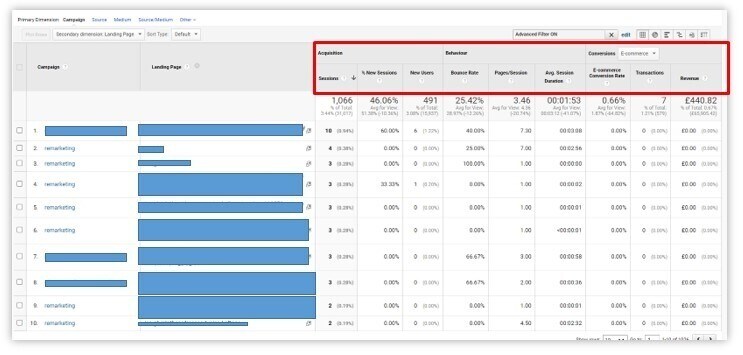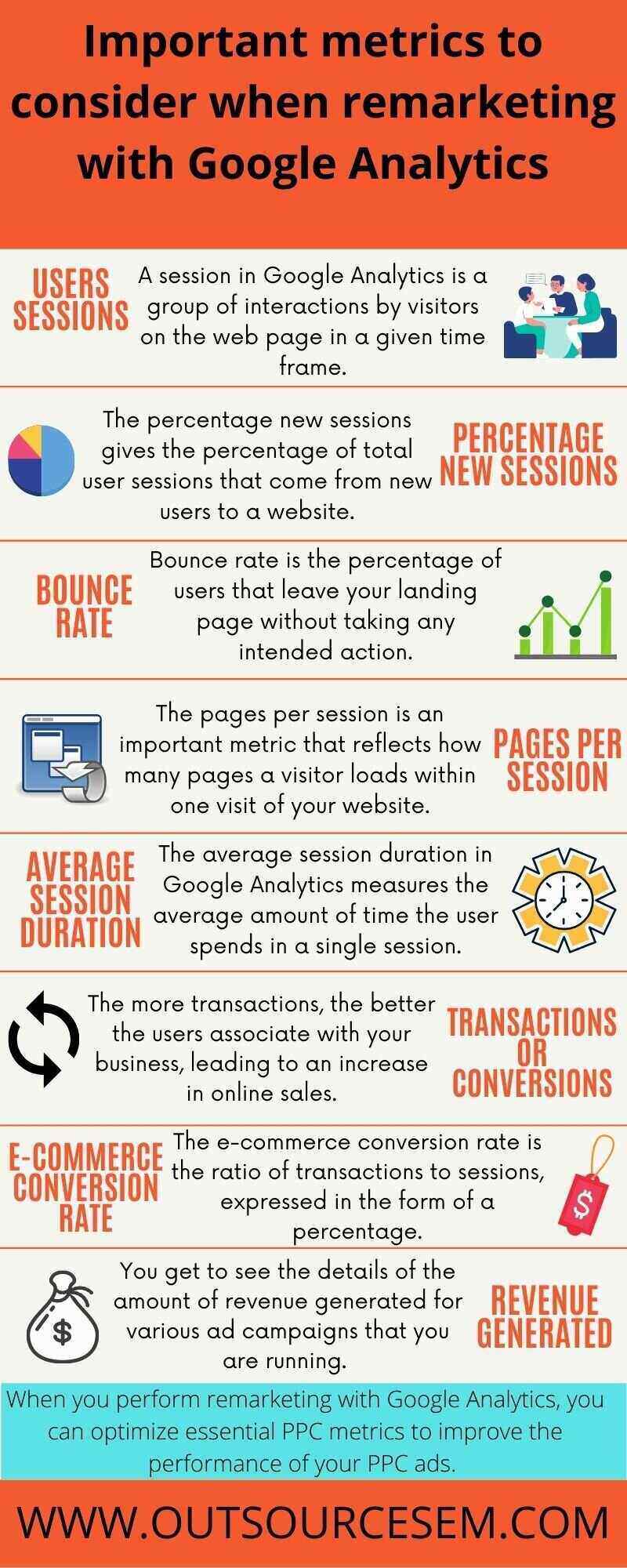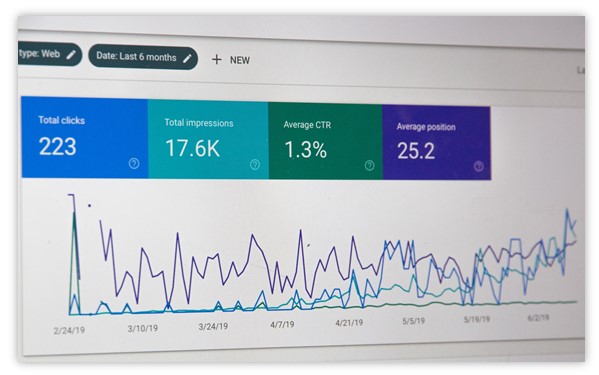Often, you must have clicked on a PPC ad but due to one reason or another, you ended up exiting the landing page without taking any desired action. Or you must have visited an e-commerce store and added products to the cart but did not check out? The next day or week, while browsing through the internet, you come across an ad from the same company. This means that the business is performing remarketing as they think you are a potential customer for them. Remarketing is a form of digital marketing in which advertisers serve ads to users who have clicked their ads before. Going ahead in the blog, we will discuss how remarketing with Google Analytics helps you achieve desired goals.
PPC ads are run by millions of businesses worldwide and are a powerful way to achieve the desired business goals like building brand awareness, driving qualified traffic to the landing page, boosting sales, filling forms and much more. With Google being the largest search engine to date, digital marketers are always on their toes to run Google PPC ad campaigns in sync with the constant algorithmic changes, ranking updates, penalties, etc. For instance, Google has announced that you would no longer be able to create or edit expanded text ads starting June 30, 2022. However, you can still pause and resume the expanded text ads if you wish. So, digital advertisers need to work on their PPC plan & strategy accordingly so that none of the target audience is left untouched.
When running an ad campaigns, you not only need to focus on retaining the users already engaged with your ads but also perform remarketing to get in touch with those who have interacted with your ads but may or may not have taken the intended action. One of the ways to accomplish remarketing is having a Google Ads account linked with Google Analytics. So, let us see how remarketing with Google Analytics would give insights on important KPIs like pages per session, percentage of new users, etc., which will help in boosting the conversion rate.

Important metrics to consider when remarketing with Google Analytics

1. Sessions - A session in Google Analytics is a group of interactions by visitors on the web page in a given time frame. When remarketing with Google Analytics, you can make the best use of the Google Analytics data to improve the performance of the PPC campaign. Google Analytics calculates the session data when a user visits a page and ends by default after 30 minutes of inactivity. Any user that returns to the landing page within 30 minutes is counted in the original session. However, if any activity is performed after 30 minutes, it is calculated as the next session.
Sessions in Google Analytics informs you of the users’ interest in your landing page. The more time the users spend on the landing page, the higher are the chances that they would navigate through different sections on the page and take the desired action. So, when you prepare your remarketing list, you must consider writing great product page descriptions, optimizing images, etc., so that you can lock the users' interest and prompt them to take the intended action. When remarketing with Google Analytics, you need to focus on having the details of session duration that highlight how much time visitors are spending on the landing page. This would help in better execution of the remarketing campaign. Analyzing the sessions data in your remarketing list can be somewhat unclear, so it would be better to outsource digital analytics services as it would lay a ground for your better understanding of the technicalities and also boost traffic, increase online sales, etc.
When performing remarketing with Google Analytics, you should focus on building brand awareness so that the users choose your brand name every time when a search term or keyword related to your business is entered. There may be chances that the same user visits your landing page various times. So, every time the user visits your web page, it is counted as a new session. When you have set up a Google Analytics account, you get to see the visitors' timing details in the acquisition tab. This section has a column that highlights the session details for different ad campaigns that are running at a given time.
2. Percentage new sessions - When performing remarketing with Google Analytics, another important metric that you need to focus on to generate leads for your PPC ads is the percentage new sessions. The percentage new sessions gives the percentage of total user sessions that come from new users to a website. This metric is essential as it helps to track two performance goals mentioned below.
a. The extent to which old users to your website are being retained.
b. The number of new users that are being attracted to the website.
When performing remarketing with Google Analytics, you focus on attracting new users to your various ad campaigns like expanded text ads, responsive ads, text ads, video ads, etc. So, every time a new user visits your website, the new session for your landing page is noted. You need to focus on attracting users with high chances of taking the intended action. It is essential to have the details of the users who are just doing window shopping to avoid irrelevant traffic, highlight competitors seeking into the website, etc. This information can be found in Google Analytics. These are the users that have low chances of taking the intended action. The more percentage of new users you have on your landing page, the higher are the chances that the users are engaged with the content on the website. When you see an increased percentage of new users, there are high chances that the users are engaged with the product or services you are offering. As in social media marketing, you focus on building brand awareness to attract new users and promote your business page so that the users that are already engaged promote it to their friends & family, thus helping in peer-to-peer marketing. In the same way, you need to ensure that the users are overwhelmed with your offerings so that they promote it to friends & family.
3. Bounce rate - Another essential point that you need to focus on in your remarketing list is to focus on reducing the bounce rate with the help of Google Analytics data. Bounce rate is the percentage of users that leave your landing page without taking any intended action. When you work on a Google Analytics setup, you need to focus on the point that you have a reduced bounce rate for your PPC ads.
As in PPC ads, you have to pay money to the search engines every time a click is made on your ads, so you need to ensure that the ad budget does not get wasted on the irrelevant clicks. You may be running LinkedIn Ads, YouTube Ads, Facebook Ads, etc. you have to pay money for every click received on your ad. So, you cannot have users clicking on your PPC ads and then leaving your landing page. With a proper bidding strategy, you can work on raising and lowering the bid amount so that none of the target audience is left untouched.
As there are marketing trends that keep evolving with time, the bounce rate of your ad campaigns varies accordingly. To increase the users' trust in your website, you must consider running holiday ads, updating ad descriptions, writing engaging ad copy, etc. It makes the users feel that the business provides products or services as per the users' intent. In your remarketing strategy, as you focus on building an email marketing list, performing content marketing, etc. similarly, you need to focus on conducting e-commerce keyword research, choose high traffic relevant keywords, etc. to get in touch with the relevant audience that have high chances of taking the intended action.
The more time the users spend on the webpage higher are the chances that they would take the intended action, thus reducing the bounce rate. In your Google Analytics remarketing strategy, some points that you can consider are listed below.
a. Ad campaign segmentation like search ads campaigns, display ads campaigns, etc.
b. Device segmentation.
c. Optimizing your ads for mobile devices.
d. Improving page load time.
e. Focus on ad relevancy.
f. Using appropriate keywords.
4. Pages per session - In your remarketing strategy, another point that you need to focus on is using the Google Analytics data to highlight the pages per session. The pages per session is an important metric that reflects how many pages a visitor loads within one visit of your website. After the user clicks on your PPC ad and reaches the landing page, there are chances that the user’s mind shifts to other different products or services that you offer. So, every different page that the user visits in a single visit is calculated as pages per session.
When you perform a Google Analytics setup, you must have a focus on some of the essential metrics to work on to achieve the desired advertising goals. So, you must consider using this Google Analytics data to view the pages per session. The more pages per session you have give a clear idea that the visitors are engaged with the content on your landing page. So, in your Google analytics remarketing strategy, you must consider using an eye-catching call to action so that the users also reach different pages and do not stick to only the page they were actually looking for. The more pages that the user visits, the higher the chances of the user taking the intended action. This is an added advantage for your ad campaigns as it helps in lead generation and boosts sales & revenue for your business.
Of the wide variety of PPC KPIs that you analyze after performing a PPC audit, one of the crucial metrics you need to focus on in your Google Analytics remarketing strategy is the pages per session. As in Google SEO, you work on improving the performance of SEO campaigns by making changes in On-page SEO and Off-page SEO so that the user navigates through different sections on the website. In the same way, when remarketing with Google Analytics, you need to focus on optimizing images, writing great content, adding ratings & reviews, etc., to make the visitors reach different pages on the landing page. Some of the points you can consider when preparing a remarketing list in Google Analytics are listed below.
a. Focus on link building.
b. Add internal links to different pages.
c. Using canonical tags so that the search engines do not find content on the landing page as duplicates.
d. Including pagination in your remarketing list so that the users easily reach multiple pages.
5. Average session duration - The average session duration in Google Analytics measures the average amount of time the user spends in a single session. It is calculated by dividing the total time spent across sessions by the total number of sessions. As you have various PPC metrics that highlight how your ad campaign is performing, it is crucial to know what time on average the user spends on the website.
As you focus on increasing the users' dwell time, you also need to increase the average session duration of the users so that they navigate through different sections on the website. The more time the users spend on the website, the higher are the chances that they would look for various products or services that your business offers. When remarketing with Google Analytics, the remarketing list that you prepare should focus on having the user's details as to what time they spent in every session. With the Google Analytics data, you get to know which pages on the website the users are finding more interesting. As in SEO pagination, you focus on dividing the website into various sections so that the users can easily reach the desired page number they are actually looking for on the website; similarly, in PPC ads, you need to focus on displaying the relevant content or ads that highlight the content as per the users’ interest so that they are interested in making a click on the displayed content and take the intended action.
There may be multiple pages present on your website and each page would have different products or service offerings. With the Google Analytics account, you know which pages drive more traffic than others. Once you get to know the details of which pages the users are finding more interesting, you can work on taking the necessary steps to update the content on the page, optimizing images, using short - engaging videos of your product or services, etc. so that the users dwell time on the website increases. In the Google Analytics account, you would find the average session duration in the hh:mm:ss format (for example, 00:06:00 for 6 minutes). Some of the points that you can focus on increasing the average session duration are mentioned below.
a. Include engaging videos.
b. Use eye-catching images.
c. Understand the users buying journey.
d. Track the essential PPC metrics.
e. Write great content so that it is easy to read.
f. Focus on demographic targeting.
g. Divide your pages into different sections and subsections.
6. Transactions/Conversions - Another important metric to focus on when performing remarketing with Google Analytics is the number of transactions. The ultimate goal of running PPC ads is to ensure that maximum transactions are completed. Transactions in Google Analytics indicate the number of conversions. This may vary from business to business, such as form fill-ups, lead generation, brand awareness, etc.
A transaction in Google Analytics is essential for e-commerce websites that measure sales activity. The e-commerce industry keeps enhancing with the changes in the online marketing world. So, it becomes quite critical to determine the performance of e-commerce PPC ads so that the ad budget does not get wasted on irrelevant clicks. Having a detailed data-driven report of the number of transactions being executed shows that your products match the users' intent. It highlights the efforts of your marketing strategy. When performing remarketing with Google Analytics, the prime focus of your remarketing strategy is to increase the number of transactions so that you have a better conversion rate for your PPC ads. After analyzing the data from transactions, you can perform remarketing to move the target audience down the sales funnel.
When remarketing with Google Analytics, you need to have the details of transactions to plan your remarketing strategy accordingly. Whether performing SEO remarketing or remarketing with PPC ads, you wish to see an increased number of transactions. The more transactions you have on your website, the better it signifies your brand recognition and how popular users are with your brand name. When digital marketing during Coronavirus had a different impact on how users switched to online marketing and you must have seen more transactions for your business. Some of the points you can focus on to increase transactions are mentioned below.
a. Optimize quality score.
b. Perform competitor analysis.
c. Optimize ads for mobile devices.
d. Mobile-friendly landing pages.
e. Work on bidding strategies.
f. Build brand awareness on social media platforms.
7. E-commerce conversion rate - The e-commerce conversion rate is the ratio of transactions to sessions, expressed in the form of a percentage. E.g., a ratio of one transaction for every ten sessions would make an e-commerce conversion rate of 10%. When remarketing with Google Analytics, another essential aspect that you can deal with is the e-commerce conversion rate.
As e-commerce is becoming an integral part of online marketing, businesses dealing in this sector wish to run e-commerce PPC ads so that the relevant audience can get in touch with the products being offered. Another critical point that you need to focus on is that your product or services need to be in sync with the marketing trends. The users feel that the business provides products that match the latest e-commerce trends. The higher the e-commerce conversion rate, the more the users trust your brand and the customer acquisition cost for your business. Some of the crucial points that you can focus on to improve the e-commerce conversion rate are mentioned below.
a. Offer discounts & sales.
b. Perform a/b testing to identify the best version of your ad campaigns.
c. Offer free shipping to users.
d. Focus on running holiday ads to attract more users to your business.
e. Use quality images.

8. Revenue generated - All the efforts in digital marketing PPC campaigns are to increase revenue for your business. When remarketing with Google Analytics, you need to see what is the amount of revenue generated for your business. Although the amount of ad budget that you spend and the number of users that make a click on your Google Ads can be seen in the Google Ads account. However, when remarketing with Google Analytics, you get to see the details of the amount of revenue generated for various ad campaigns that you are running. These may be responsive ads, expanded text ads, search ads, mobile ads, video ads, etc. WIth a proper bidding strategy and avoiding PPC myths, you can increase the revenue for your business. The Google Analytics data clearly represents the amount of revenue generated for your business and you can work on taking the necessary steps to optimize the Google Ads performance to achieve the desired advertising goals.

Why perform remarketing with Google Analytics?
Google Analytics is an essential tool that highlights the details of your business. With the various targeting options available in the Google Analytics account, you get to see the details of Google Ads. After you have performed a Google Analytics setup, the major advantage you get with Google Analytics is seeing the details based on audience segmentation. The Google Analytics account data provides a clear detail about the target audience. As various users follow a different path to reach the landing page, you need to prepare a report where you get most of the traffic from. As you prepare an attribution report to determine where your traffic comes from, in the same way, Google analytics would help you know whether the display ads on Google Display Network drive traffic, your social media marketing tactics are working fine, etc. You need to link your Google Ads account with Google Analytics to benefit from remarketing with Google Analytics. Some of the benefits of remarketing with Google Analytics are listed below.
a. Perform conversion tracking - With remarketing with Google Analytics, you can perform conversion tracking. Whether it is search engine optimization or pay-per-click advertising, not all users who reach the landing page take the intended action. With the help of remarketing with Google Analytics, you get to see the details of users who take the intended action and others who just do window shopping. After performing conversion tracking, you can work on preparing an email marketing list and then perform email marketing, content marketing, etc. to lure visitors into clicking on your Google Ads.

b. Understand user behavior - Another essential point that you can focus on in your remarketing strategy is to work on understanding user behavior. With the Google Analytics account setup, you can work on audience segmentation and then decide to run personalized ad campaigns. The Google Analytics data help you to work on building users' buying persona so that you run ad campaigns that best match the users' search term or keywords entered.
c. Track online traffic - With the help of Google Analytics data, you can track the online traffic for your ads. There are chances that your Google Ads may receive increased impressions but these users may not be clicking the ads. So, it means that your ads have a high chance of receiving more number of click but due to some ad fatigue or improper ad description, ad headlines, you are missing the relevant audience.

d. Prepare custom report - With the help of a Google Analytics account, you can prepare a custom report. The more details you have about your ad campaigns, the better-informed decisions you can make better-informed decisions about your ad campaigns. As you consider preparing a PPC report to determine which of the landing pages have performed well over a specific duration, you can prepare a custom report that highlights the details of the ad campaign over a defined period. You can then focus on conducting a keyword research for your ad campaign that would help increase the traffic to your PPC ads.

e. Track e-commerce performance - With the help of Google Analytics, you can see the e-commerce PPC ads performance. As the e-commerce industry is advancing rapidly, you must have noticed that e-commerce ads have started appearing on various social media platforms, display networks, etc. With the increase in affiliate marketing, the e-commerce industry is driving online marketing rapidly compared to traditional marketing. So, after tracking the e-commerce performance, you can work on e-commerce keyword research to see an increase in online sales.

Final thoughts
Now that you have an idea of how crucial remarketing with Google Analytics is for your Google Ads, you must consider remarketing with this. When done correctly, remarketing audiences can open doors for your business and ensure optimal reach through Google Ads to increase conversion rate. When you have completed the Google Analytics setup, you need to link it with the Google Ads account to see the essential points you need to analyze in your remarketing list. You can outsource a digital marketing company with a Google Analytics expert that can work best on the remarketing audience, local service ads, PPC audit, competition analysis, etc. The professionals craft ad campaigns that cater to uses intent and write resonating content so that the users take the intended action. OutsourceSEM also provides high-quality PPC services like electrician PPC, flooring PPC, roofing PPC, lawyer PPC, and small business PPC services that are customized to help your home service or small business succeed. Our expert team specializes in generating high-quality leads and enhancing ROI for various industries, including electrician, flooring, roofing, lawyer, and small business services.
References
• Remarketing with Google Analytics
• About remarketing audiences in Analytics
